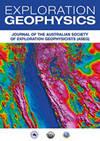基于视觉显著性的地震多属性精细断层可视化方法
IF 0.8
4区 地球科学
Q4 GEOCHEMISTRY & GEOPHYSICS
引用次数: 1
摘要
这项研究改进了从Krishna Godavari(KG)盆地获得的三维数据中检测细微断层的属性集合,结果显示在合成和真实数据集上。地震属性,例如曲率和相干性,通常用于描绘不连续性,例如可能捕获碳氢化合物的断层和裂缝。这些属性对地震数据具有主观优势。在本文中,我们提出了一个用于识别地震体内部细微断层的多属性框架。曲率属性是处理这些断层的一种强大而流行的技术。利用最小二乘法将断层层位拟合在二次曲面上,计算出最正曲率和最负曲率的属性,并将其进一步用于显著性图的计算。几种信号处理技术,如霍夫变换和蚂蚁跟踪,已被用于描述断层。在这里,我们提出了一种新的基于能量变化的信号处理方法,称为使用3D-FFT局部谱和多维平面投影的曲率属性上的自上而下显著性。为了分析地震数据的方向性,采用了方向中心环绕技术来进行视觉注意。此外,对数Gabor滤波器和图像侵蚀被应用于显著性渲染的地震体,以突出断层处的定向振幅不连续性。大多数时候,这些不连续性可能不是很突出,无法在三维地震数据中找到隐蔽的断层和其他痕迹来追踪隐藏的地质特征。在我们的工作中,计算的属性有助于我们绘制这些变化,因为它们对断层和裂缝的敏感程度都不同。在Krishna-Godavari盆地实际地震资料上的实验结果证明,该算法在追踪细微断层和小断层方面是有效的,优于以往的工作。本文章由计算机程序翻译,如有差异,请以英文原文为准。
Seismic multi-attribute approach using visual saliency for subtle fault visualization
This study improves a collection of attributes to detect subtle faults in three dimensional data obtained from the Krishna-Godavari (KG) basin, with results displayed on synthetic and real datasets. Seismic attributes, for instance, curvature and coherence, are often used to delineate discontinuities, such as faults and fractures where hydrocarbons may have been trapped. These attributes have their advantages subjective to the seismic data. In this paper, we propose a multi-attribute framework for identifying subtle faults inside seismic volumes. Curvature attribute is a powerful and popular technique to deal with these faults. The faulted horizon is fitted on the quadratic surface using the least-square method, and the most positive and most-negative curvature attributes are calculated, which are further used in saliency map calculations. Several signal processing techniques, such as Hough transform and ant tracking, have been used to delineate faults. Here, we have proposed a novel signal processing approach based on energy variations known as top-down saliency on the curvature attributes using 3D-FFT local spectra and multi-dimensional plane projections. To analyze the directional nature of seismic data, the directional center-surround technique is employed for visual attention. Furthermore, the log-Gabor filter and image erosion are applied to the saliency-rendered seismic volume to highlight the oriented amplitude discontinuities at faults. Most of the time, these discontinuities may not be very prominent to find the subtle faults and other trace-to-trace hidden geological features in three-dimensional seismic data. In our work, calculated attributes assist us in mapping these changes, because they are all differently sensitive to the faults and fractures in unique ways. Experimental results on real field seismic data from the Krishna-Godavari basin prove that the proposed algorithm is effective and efficient in tracking subtle and minor faults, better than previous works.
求助全文
通过发布文献求助,成功后即可免费获取论文全文。
去求助
来源期刊

Exploration Geophysics
地学-地球化学与地球物理
CiteScore
2.30
自引率
0.00%
发文量
33
审稿时长
>12 weeks
期刊介绍:
Exploration Geophysics is published on behalf of the Australian Society of Exploration Geophysicists (ASEG), Society of Exploration Geophysics of Japan (SEGJ), and Korean Society of Earth and Exploration Geophysicists (KSEG).
The journal presents significant case histories, advances in data interpretation, and theoretical developments resulting from original research in exploration and applied geophysics. Papers that may have implications for field practice in Australia, even if they report work from other continents, will be welcome. ´Exploration and applied geophysics´ will be interpreted broadly by the editors, so that geotechnical and environmental studies are by no means precluded.
Papers are expected to be of a high standard. Exploration Geophysics uses an international pool of reviewers drawn from industry and academic authorities as selected by the editorial panel.
The journal provides a common meeting ground for geophysicists active in either field studies or basic research.
 求助内容:
求助内容: 应助结果提醒方式:
应助结果提醒方式:


